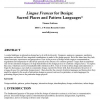Free Online Productivity Tools
i2Speak
i2Symbol
i2OCR
iTex2Img
iWeb2Print
iWeb2Shot
i2Type
iPdf2Split
iPdf2Merge
i2Bopomofo
i2Arabic
i2Style
i2Image
i2PDF
iLatex2Rtf
Sci2ools
ACMDIS
2000
ACM
2000
ACM
Lingua Francas for Design: Sacred Places and Pattern Languages
A central challenge in interaction design has to do with its diversity. Designers, engineers, managers, marketers, researchers and users all have important contributions to make to the design process. But at the same time they lack shared concepts, experiences and perspectives. How is the process of design-which requires communication, negotiation and compromise-to effectively proceed in the absence of a common ground? I argue that an important role for the interaction designer is to help stakeholders in the design process to construct a . To explore this issue, which has received remarkably little attention in HCI, I turn to work in urban design and architecture. I begin by discussing a case study in community design, reported by Hester [10], that demonstrates the power of a for a particular design project. I then describe the concept of pattern languages and discuss how they might be adapted to the needs of interaction design in general, and used, in particular, as meta-languages fo...
| Added | 01 Aug 2010 |
| Updated | 01 Aug 2010 |
| Type | Conference |
| Year | 2000 |
| Where | ACMDIS |
| Authors | Thomas Erickson |
Comments (0)

